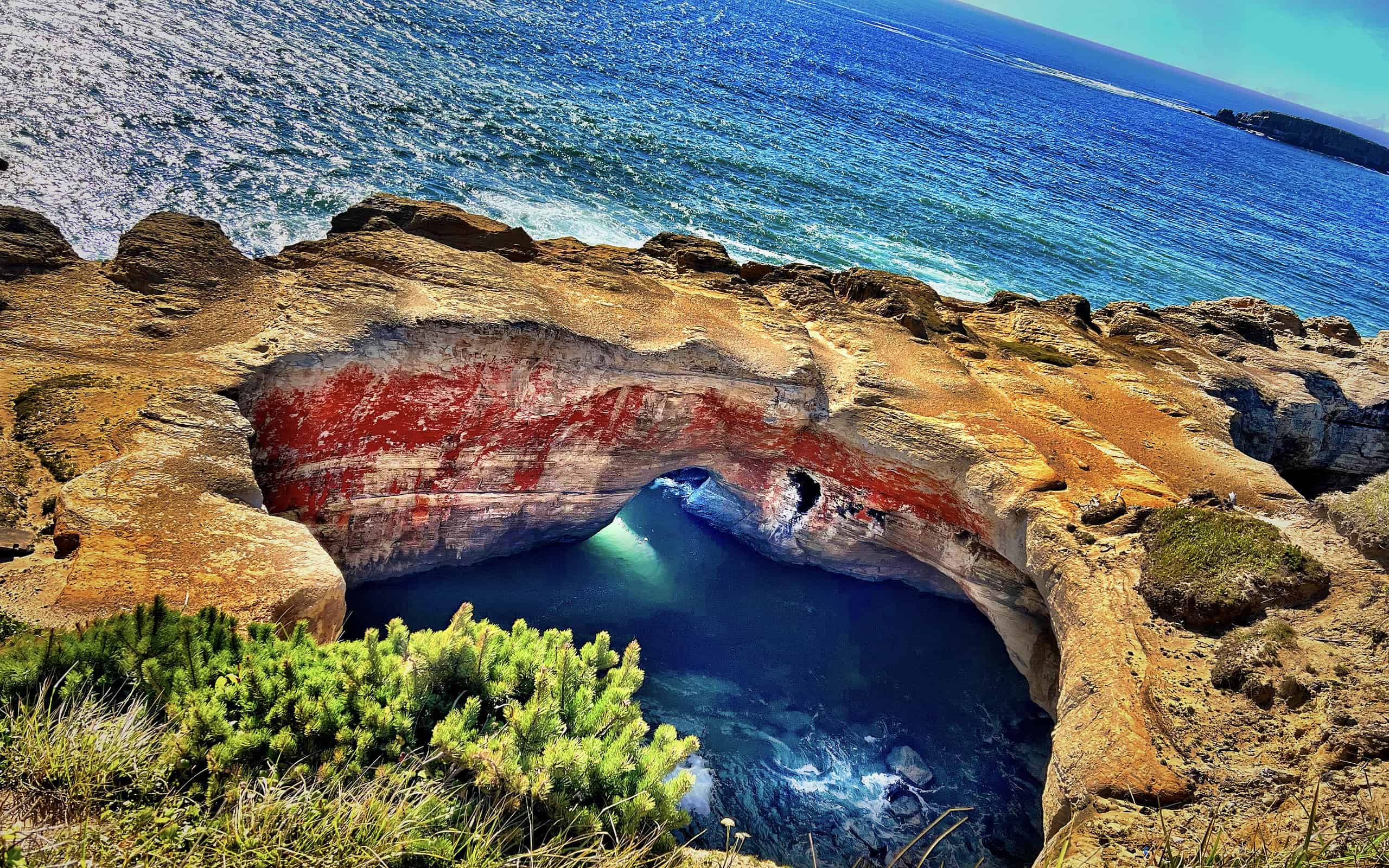Known for gorgeous outdoor, natural attractions and areas, Oregon has stunning caves and caverns you’ll want to explore. In fact, some of the most beautiful underground wonders are caves in Oregon along the coasts, in the forests, and near rivers.
Make a road trip of it and explore them all, or pop into a few to explore these gorgeous natural wonders. Just know that some planning ahead may be required, as some of the caves in Oregon require special tours or may not be open all year round.
1. Oregon Caves National Monument

Oregon Caves National Monument and Preserve contains some of the most stunning geological formations in the state of Oregon. The beautiful floor-rooted stalagmites and ceiling-hanging stalactites are just part of the attraction.
©Oregon Caves from Cave Junction, USA / flickr – Original / License
Probably the most well-known caves in Oregon are the Oregon Caves at the National Monument of that name. The monument, managed by the National Park Service, bears the nickname of the “marble halls of Oregon.” These caves may be witnessed on ranger-led tours from March to November each year, via different tour types. Enjoy the geology explanations during the Discovery Tour. Or experience the caves via the Candlelight Cave Tour, lit only by candles as you walk through the history of the region. Or, if you’re game for a more intense adventure, go for the Off-Trail Tour and get your spelunking on.
Situated in the coastal Siskiyou mountain range along the Oregon-California border, the caves are some of the wildest and most beautiful in the state. The caves consist of 15,000 feet of marble rock tunnels winding their way through the region, the only accessible marble cave in the state.
2. Sea Lions Cave
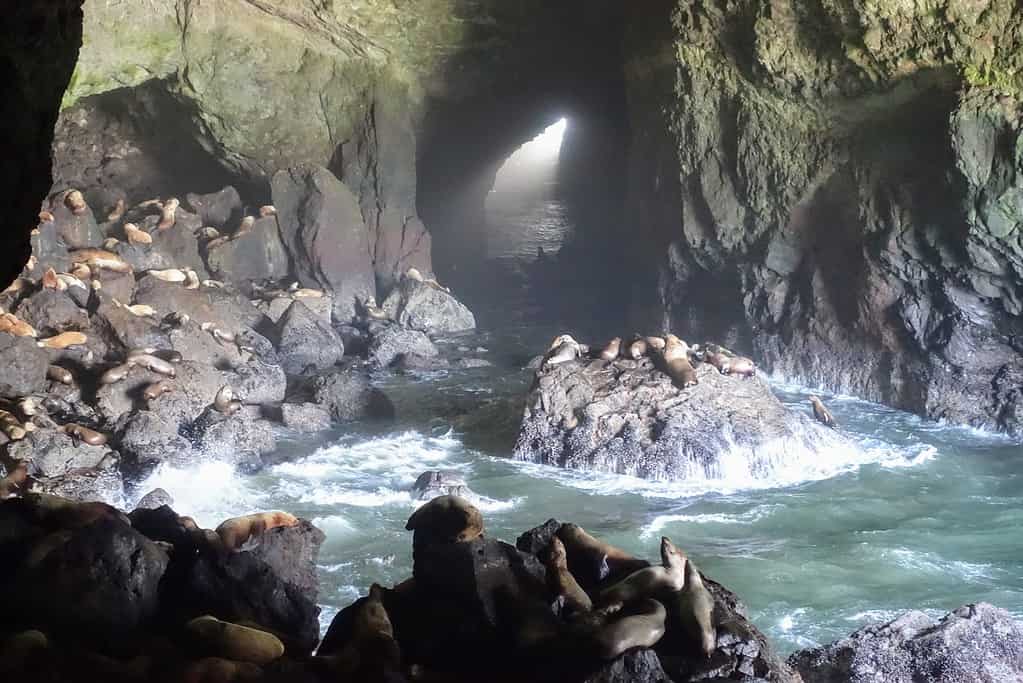
California sea lions make their way to the Sea Lions Cave outside Florence, Oregon, United States. This offers visitors a unique up-close-and-personal view of these incredible marine mammals while also exploring an amazing sea cave in Oregon.
©Chris Babcock/ via Getty Images
For those looking for a gloriously beautiful cave that’s easy to maneuver, head to the Sea Lions Cave along the Oregon coast. The cathedral-like caves welcome the seasonal sea lion rookery each year, earning its name, along with visitors coming to witness both the wildlife and the underground wonders of the caves.
The largest known sea cave in the United States, Sea Lion Caves are accessible via elevator ride down into depths, landing at sea level. Walk into the sheltered room of interpretive signage and listen for the barking calls of the sea lions, if they’re in season. Visit the caves in winter for sea lions but be sure to wear a warm jacket! It’s chilly down there!
3. Lava River Cave
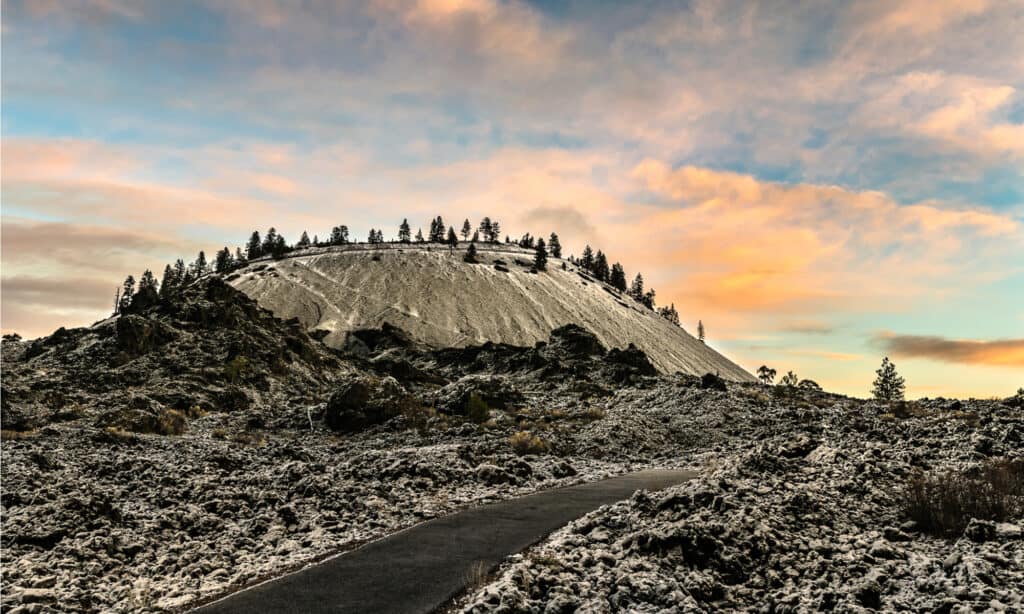
The Newberry National Monument within the Deschutes National Forest contains one of the most intriguing cave systems in Oregon, the Lava River Cave.
©Jason Cornell/Shutterstock.com
One of the most popular cave stops in Oregon, the Lava River Cave stretches a mile long as a lava tube. The cave may be accessed via stairs and a Northwest Forest Pass or day pass if you’re just around the afternoon. Follow the boardwalk and uneven surfaces to the stairs and wander the lava tube until you reach the end where sandbags block further wandering.
Lava River Cave lies within the Newberry National Monument within the Deschutes National Forest. This is the longest known and earliest discovered lava tube in the state and has become one of the most popular for this length and reasonable ease of access. Take the self-guided tour, but be prepared for that 2-mile round trip adventure with a warm jacket, some water, and proper footwear.
Note that Lava River Cave is only open from May to September, with limited hours via reservations available for the rest of the year. Be sure to plan ahead!
4. Boyd Cave
Another exciting lava tube to explore in Oregon is the 1,880-foot-long Boyd Cave just southeast of Bend, Oregon. The cave may be accessed via a set of metal stairs leading downward through a small opening in the ceiling. The chilly cave, hitting only 42 degrees, is open year-round for exploration.
Boyd Cave is considered beginner-friendly and connects to the Arnold Cave network. The cave bears all the exciting, wild features of a typical high desert lava tube. But you’ll need to do a little hiking and searching to find the entrance. Boyd Cave sits off the beaten path, along the China Hat Road, found only via the sometimes hard-to-find signage. Some entries are blocked off by bars, while one or two may be found.
All around the cave, you’ll find plenty of hiking, as well, with views of the Three Sisters’ stunning peaks in the distance.
5. Redmond Caves
Within the city limits of Redmond, Oregon, you’ll find the Redmond Caves, a system of five caves. The caves were formed when a local lava tube collapsed. You’ll find caves 1, 3, and 4 are accessible, with a network of passages, while caves 2 and 5 are shallow and small, mostly inaccessible.
The Redmond Caves are open year-round for exploration, breaking away from the heat of the high desert. The site has not seen full development, so no fees are required. Of course, no tours are available and no facilities, no lights, and no other amenities are nearby. Bring a flashlight, dress warmly, and prepare with good walking shoes. Be sure to go in with others and let folks know where you are, too, before you go exploring down there.
6. Skylight Cave

Skylight Cave in Oregon is one of the most popular choices for folks able to explore and climb…down.
©Karl Sanchez/ via Getty Images
Open from May to September, the Skylight Cave attracts visitors from all over with its incredible beauty. Make your way down the ladder into the cave, entering into the large room with a 25-foot ceiling. Here, an opening in the roof lets in a shaft of light, like a skylight beaming into a house. Three total skylights sift into the room in this otherwise fairly common cave in Central Oregon.
The cave rests off the typical tourist trail, requiring that climb down into the cave. It’s relatively easy to access otherwise, but you will wind up with some muddy boots. The best time to visit is on bright, sunny mornings when the angle of the sun hits the skylights just right to show off those incredible beams.
7. Arnold Ice Cave
Situated near Bend, Oregon, the Arnold Ice Cave meets up with the rest of a massive underground tunnel system formed by lava flows. This particular cave tends to accumulate ice, earning its name, largely due to the fact that no sunlight ever touches the interior tunnels and chambers of the system, while groundwater seeps into the cold via cracks and crevices in the rocks.
Head down the Hidden Forest Trail near the bend, just 0.9 miles, to reach the cave. Wear footwear with good traction for your excursion since the ice definitely gets slippery. Bring along a flashlight and wear warm clothing.
The cave is open from May to October and requires no entry fee or guide.
8. Hidden Forest Cave
Near to the Arnold Ice Cave, as part of the system, the Hidden Forest Cave rests along the Hidden Forest Trail. Walk about 10 to 20 minutes past Arnold Ice Cave to find a magical cave with a hidden forest inside! Along the way, you’ll spot wildflowers and maybe some wildlife, but once inside, you’ll see this magnificent interior forest within.
The gradual, short descent down the trail to the cave requires no special hiking skills, but entry requires scrambling over boulders to view the interior. Many hikers report the correct trail and ultimately the Hidden Forest Cave are rather difficult to find, but with persistence and care, you’ll come across it located 3 miles south of Boyd Cave along the China Hat Road. Stay straight on the trail, avoiding the many turnoffs, and hike around the edge of the crater to find the entrance.
No tours exist for Hidden Forest Cave.
9. Fort Rock Cave

Fort Rock State Park is near Bend, Oregon, USA, where folks explore the Fort Rock Cave on their own.
©brown54486/ via Getty Images
Located near Fort Rock, an attraction that draws many visitors to the area, Fort Rock Cave once held several pairs of sagebrush sandals believed by archeologists to be 9,000 to 11,000 years old, covered in volcanic ash. The cultural and archeological significance of the cave means limits of ranger-led tours are available each summer. No one may visit Fort Rock Cave apart from a tour. So, reserve your spot early!
Fort Rock lies within the bed of a long-dry sea, formerly covering an ancient volcano. Within the rock formations here, the cave once housed some of the earliest known evidence of humans in the region. The cave once went by other names, as well, like Menkenmaier, Cow, and Reub Long Cave, but ultimately landed with the name for the nearby fort.
Fort Rock Cave was declared a National Historic Landmark in 1961, as well as a National Heritage Site, and now they, along with the fort, make up Fort Rock State Natural Area.
10. The Devil’s Punchbowl
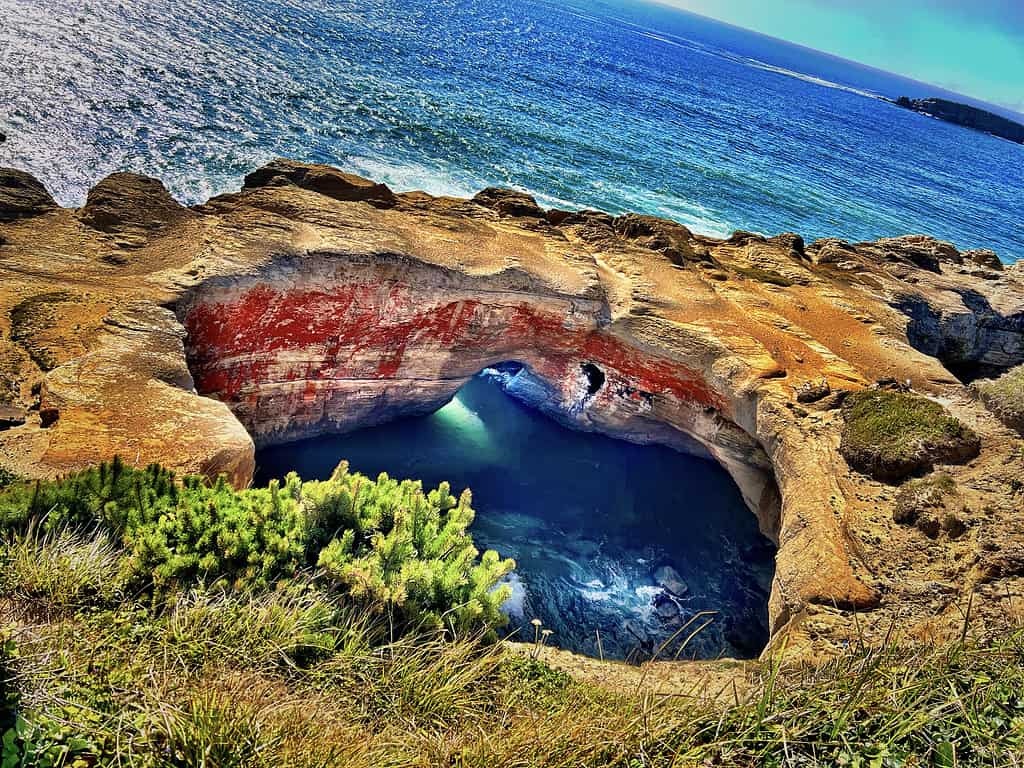
The Devil’s Punchbowl offers a unique and amazing viewpoint, while also being an incredibly beautiful cave in Oregon. You’ll have to climb down the embankment to get inside, though!
©Rick Myers/ via Getty Images
One of the other most well-known caves in Oregon, the Devil’s Punchbowl rests along the Oregon coast. Most folks admire the view from the parking lot and light walking paths nearby, but some venture below to the beach to explore at low tide.
To find this sea cave for exploration, walk through the neighborhood to the beach access and make your way down the sandy embankment. Head south along the beach until you find the cave entrance. The cave’s incredible aesthetics offer yellow, red, green, and purple shades, glistening in the sunlight.
No tours are available for the Devil’s Punchbowl.
11. Derrick Cave
A little way from Fort Rock Cave, you’ll find Derrick Cave, a 1,200-foot-long cave with volcanic features. The cave received its name from pioneer rancher H.E. Derrick who resided in the area. The cave’s incredible features include things like natural skylights, sandy floors, multiple levels, and more, as the cave developed along a lava tube and vent.
Derrick Cave, unlike many others in the area, is spacious and wide, at 30 feet tall and 50 feet wide, and easily traversed by most. The cave may be accessed via an unpaved dirt road in summer in Devil’s Garden. At one point, Derrick Cave was a designated fallout shelter.
There is no light source and no facilities at Derrick Cave, meaning there are also no tours. So, be sure to bring supplies, safety gear, and lighting as you explore.
12. Cave of the Winds
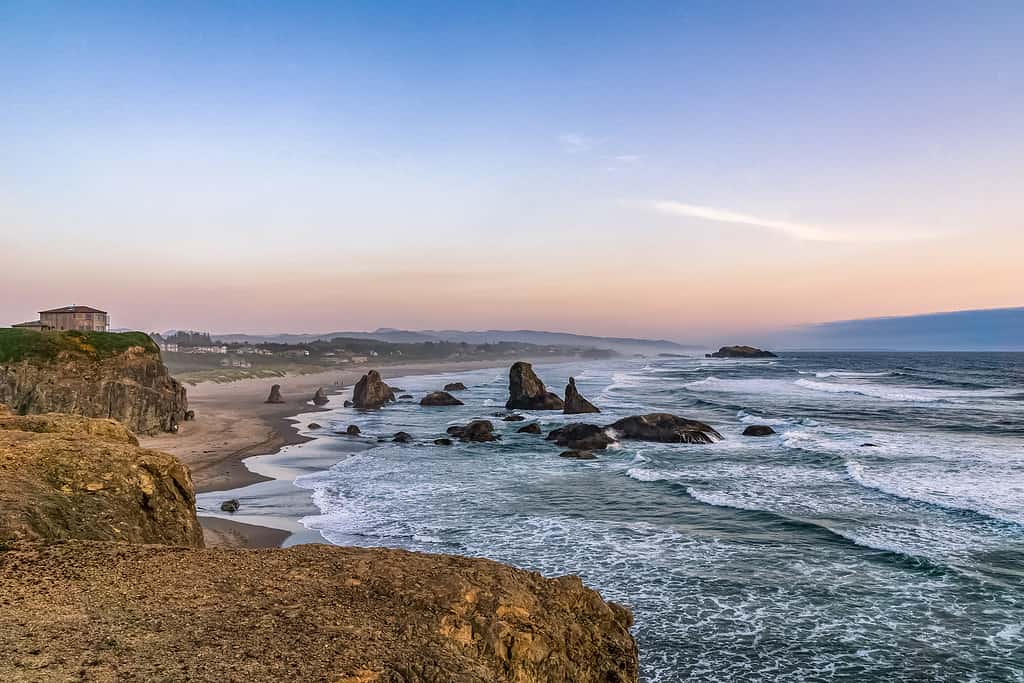
Bandon Beach includes the incredible Face Rock State Scenic Viewpoint. This is considered by many locals one of the most stunning caves in Oregon. It is also one of the accessible caves along the coast.
©libre de droit/ via Getty Images
In the southern part of Oregon, near Bandon, you’ll find the Cave of Winds, situated within the Face Rock State Scenic Viewpoint area along the coast. The viewpoint itself is the cliff that creates the Cave of Winds. You may venture inside where the cave shelters you from the salty wind. Here, admire the stunning views of the sea stacks and ocean. The viewpoint and cave show off the Cat and Kitten Rocks and Face Rock. Both have significance in local First Nations lore.
13. Paisley Caves
Within the Paisley Caves, eight caves in the dry zone of south-central Oregon, human artifacts dating back to 14,000 years ago were discovered. These are the oldest known artifacts in the United States. They date back approximately to the time when humans crossed the Bering Straits.
The cave system of Paisley Caves contains eight caves that wind their way through the Oregon Outback Scenic Byway, along the Summer Lake basin. One of the caves still holds fossilized remnants of the oldest human habitation on the continent.
Paisley Caves are easily accessible but quite remote and completely undeveloped, meaning there are no facilities or shopping nearby. Come prepared when you explore here! There are no fees or tours.
14. Horse Lava Tube System
Near Bend, Oregon, the Horse Lava Tube System comprises a series of underground caverns that ultimately connect with Redmond Caves. The Horse Lava Tube System covers much of the area between Bend and Redmond, with at least 122 known caves throughout.
Unfortunately, many of the caves have seen vandalization over the years, since their discovery around 1900. Many others lie within private property. However, some of the caves are accessible to the public. These include Stevens Caves, Lewis Farm Cave 1, Horse Caves, and Young’s Cave. Most folks head to Redmond Caves for easier access. But, if you’re up for some exploring and excitement, heading to the accessible caves of Horse Lava Tubes is a great way to do it.
15. Sandy Glacier Caves
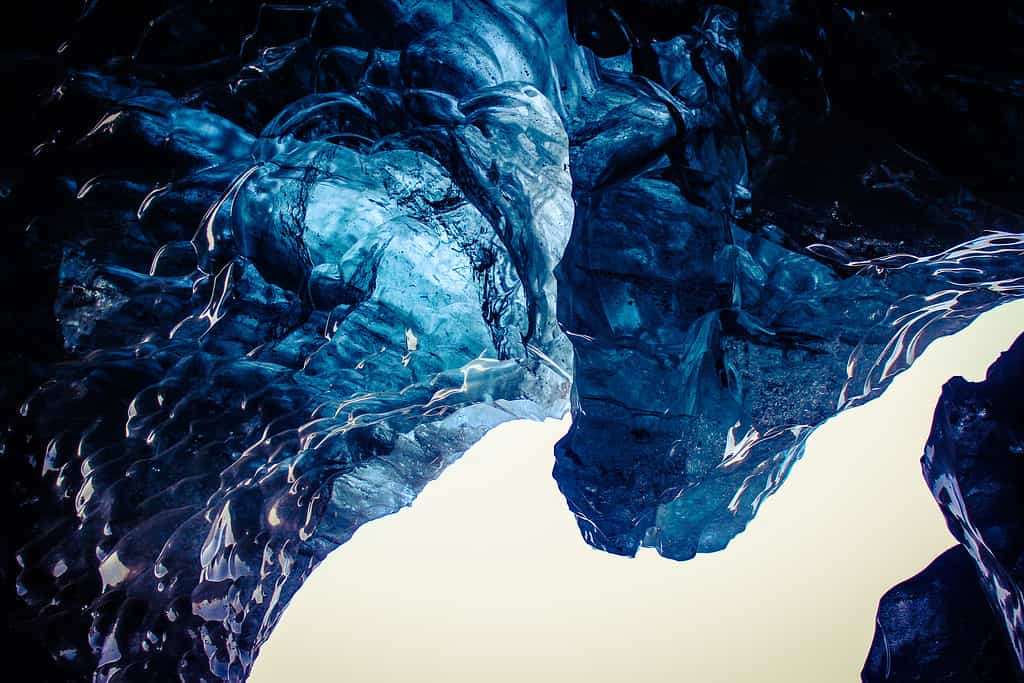
The Sandy Glacier Ice Caves welcome visitors for a while yet. But scientists are predicting this glorious blue ice cave system won’t exist within a decade. You’d better go explore now!
©Kathi Hinz/ via Getty Images
If the idea of ice caves appeals, head to the Sandy Glacier Caves, another gorgeous ice cave in Oregon. These caves are part of the largest glacial system in the lower 48 states, nestled within Mount Hood’s Sandy Glacier. Pale blue ice covers the walls, with a blanket of snow on the ground inside and out. Then the sun beams in, sparkling across the ice. The caves have names such as Frozen Minotaur Cave, Pure Imagination Cave, and the Snow Dragon Cave. These form as different caves in warmer months. But, in the winter months, the caves connect with ice and are known collectively as the Snow Dragon Glacier Cave system with the Sandy Glacier.
Scientists predict these caves will no longer exist, though, by the end of the decade. This expectation arises as the glacier continues melting, taking the caves with them.
Summary of 15 Incredible Caves in Oregon
| Cave | Location | |
|---|---|---|
| 1 | Oregon Caves National Monument | Coastal Siskiyou mountain range along the Oregon-California border |
| 2 | Sea Lions Cave | Outside Florence, Oregon |
| 3 | Lava River Cave | Within the Newberry National Monument within the Deschutes National Forest |
| 4 | Boyd Cave | Southeast of Bend, Oregon |
| 5 | Redmond Caves | City of Redmond, Oregon |
| 6 | Skylight Cave | Within Deschutes National Forest – 9 miles northwest of the city of Sisters, Oregon |
| 7 | Arnold Ice Cave | Near Bend, Oregon |
| 8 | Hidden Forest Cave | 12 miles southeast of Bend, Oregon |
| 9 | Fort Rock Cave | Near Fort Rock – close to Bend, Oregon |
| 10 | The Devil’s Punchbowl | Otter Rock, Oregon |
| 11 | Derrick Cave | Close to Fort Rock Cave |
| 12 | Cave of the Winds | Near Brandon, Oregon |
| 13 | Paisley Caves | South-central Oregon near the city of Paisley |
| 14 | Horse Lava Tube System | Near Bend, Oregon |
| 15 | Sandy Glacier Caves | Within the ice of Sandy Glacier on Mount Hood, Oregon |
Thank you for reading! Have some feedback for us? Contact the AZ Animals editorial team.

